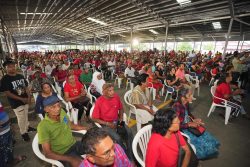Since his appointment as Minister of Health in August last year, Dr Frank Anthony has not been shy about lambasting the previous government over what he said was a “broken healthcare system”. He used those particular words during the 2020 national budget debate in September when he indicated, among other things, that critically needed drugs were either in short supply or non-existent while a large quantity of other medicines worth millions had expired and needed to be disposed of. Undoubtedly, Guyana’s healthcare system is far from being the best it could be, but to imply that it had been “broken” during the APNU+AFC’s single term in office, aside from being an insult to professionals working in the system, is a crafty attempt at pulling wool over our eyes.
Last week Monday, at a virtual press conference, Dr Anthony iterated that between August last year to now some 300 truckloads of expired items worth over $2 billion had been dumped from the Health Ministry’s Materials Management Unit (MMU). This did not include expired pharmaceuticals from the Georgetown Public Hospital Corporation. In fact, he said that $10 billion in expired drugs had been discarded between 2015 and present day. He added that his government, since taking office, had spent $12 billion on emergency supplies, $5 billion of which was on the personal protective equipment necessary for medical personnel to treat patients in the face of COVID-19.
At the same press conference Dr Anthony’s adviser Dr Leslie Ramsammy doubled down on the rhetoric, claiming that information from the regions on what drugs were needed was not being updated and utilised. He said that between 2015 and 2017, the computer system at the MMU crashed and somehow the MMU staff were no longer in charge of procurement. The glaring implication was that the previous government was simply buying pharmaceuticals willy-nilly and wasting money.
Having served as health minister of Guyana under the PPP/C administration from 2001 to 2011, Dr Ramsammy is perhaps the perfect person to expound on the procurement, shortage, and overrun of drugs. Clearly, wastage and the disposal of expired drugs must not have occurred under his watch. Except that it did.
According to the 2010 Auditor General’s Report, huge losses were suffered by the Ministry of Health due to the expiration of large quantities of drugs. Destruction of expired drugs valued at $39.955 million had occurred for the period under review, the AG’s Report said, adding that there was a large quantity of expired stock still on hand, pending processing and destruction. It noted that this had been a longstanding problem at state warehouses.
Further, an independent report on access to essential drugs in Guyana, published in 2008 following a study conducted by Ohio State University, the School of Public Health and Health Sciences and the Institute for Global Health both of the University of Massachusetts stated inter alia, “the supply and distribution of pharmaceuticals and medical supplies is a major bottleneck in the healthcare system. There are periodic shortages, delivery is often not timely, and wastage occurs because of inadequate management.” At that point, the MMU lacked adequate infrastructure for the storage of drugs, vaccines, and other medical supplies, the researchers found.
To put things in perspective, Dr Ramsammy was not the architect of the inadequate management referred to in the report. It was a system he inherited from his colleague Ms Gail Teixeira, who was health minister from 1992, and, according to the PPP/C, had done a good job of fixing the damage done by the PNC. It would not have been politically correct for Dr Ramsammy to mention any defects he found when he took over the Health Ministry. But he did not have to. Barring the report mentioned above, the trials ordinary Guyanese faced in navigating the system and finding medicines offered more than enough evidence.
Nevertheless, during Dr Ramsammy’s tenure as Health Minister, a Supply Chain Management System (SCMS) project, funded through the US President’s Emergency Plan for AIDS Relief (PEPFAR), which targeted pharmaceutical management began in 2006. This was prior to the opening of the current MMU bond at Diamond, which was not completed until 2013, by which time, Dr Ramsammy had been replaced at the Health Ministry by Dr Bheri Ramsaran.
Though its primary focus was on HIV medications and supplies, when the project wrapped up in October 2016, over 1,000 staff members had been trained, some of them overseas, in managing, planning, procuring and distributing all pharmaceuticals in Guyana. Furthermore, according to then US Ambassador to Guyana Perry Holloway, the project had “developed computerised systems for requesting, tracking, storing and distributing all… drugs and supplies” in the public health sector.
If the claims made by Dr Ramsammy and Dr Anthony are to be believed, then one has to assume that the millions of dollars the US government spent on the SCMS project, including expensive computer software, have been all for naught. And this is at odds with the fact that in May 2017, the computerised drug monitoring and E-CRIV (Combined Issued and Received Voucher) system was being installed at the Georgetown Public Hospital and was already in place at the Suddie, New Amsterdam, and Linden hospitals.
One would also have to assume that the professionals, some of whom who had been trained at the US CDC in Atlanta, had become insouciant and were simply sitting on their laurels and letting things slide. Dr Anthony and Dr Ramsammy should provide the evidence to substantiate their varied claims. If not, they should dial back on the bombast and get down to doing the job they have assured us they can do.









